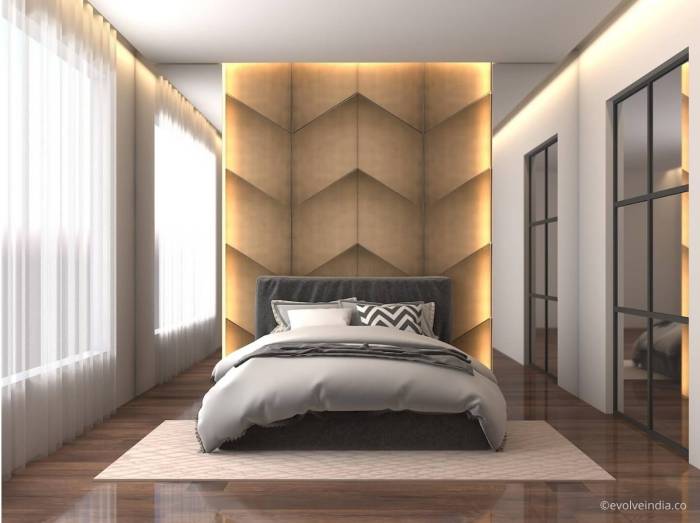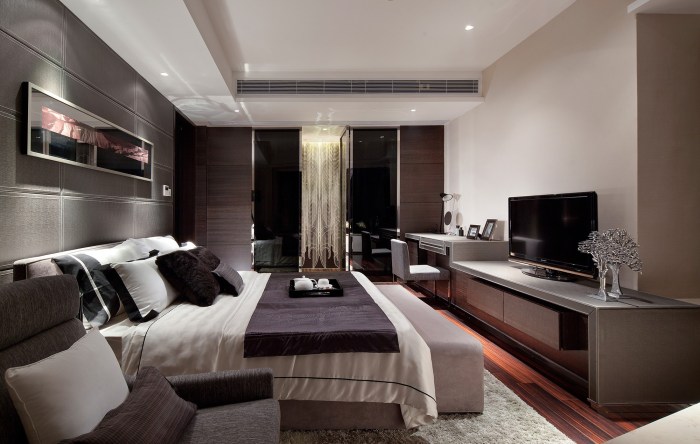Modern Contemporary Bedroom Design Ideas
Lighting Design in Modern Contemporary Bedrooms

Modern contemporary bedroom design ideas – Effective lighting is paramount in achieving the desired ambiance and functionality within a modern contemporary bedroom. The interplay of ambient, task, and accent lighting creates a layered and sophisticated illumination scheme, enhancing both the aesthetic appeal and the practicality of the space. Careful consideration of lighting temperature further refines the mood and atmosphere.
Three Distinct Lighting Schemes for a Modern Contemporary Bedroom
Creating a well-lit bedroom involves strategically combining three types of lighting: ambient, task, and accent. Ambient lighting provides overall illumination, task lighting focuses light on specific areas, and accent lighting highlights architectural features or artwork. By carefully selecting fixtures and placement, a balanced and visually appealing lighting plan can be achieved.
Ambient Lighting: This provides the overall brightness of the room. For a modern contemporary bedroom, consider recessed LED downlights for even distribution of light across the ceiling. These offer energy efficiency and a clean, minimalist aesthetic. Alternatively, a sleek, linear pendant light fixture positioned centrally can create a focal point while offering generous ambient light. A dimmer switch is crucial for controlling the intensity and creating different moods.
Task Lighting: This focuses light on specific areas requiring detailed attention. A bedside table lamp is essential for reading or other activities in bed. Opt for a minimalist design with a clean, geometric base and a simple shade, perhaps in brushed nickel or matte black to complement the modern aesthetic. Additionally, a flexible gooseneck lamp attached to the headboard provides adjustable light for reading without taking up bedside table space.
A floor lamp with an adjustable arm could provide additional task lighting in a reading nook.
Accent Lighting: Accent lighting highlights specific features or objects. In a modern contemporary bedroom, this might involve using LED strip lights under cabinets or shelves to create a subtle glow, highlighting artwork or textured walls. Recessed LED spotlights can be used to highlight a headboard or a feature wall. Indirect lighting, such as a backlit headboard, adds a sophisticated touch.
Consider using warm-toned LED strips to create a cozy atmosphere.
Modern contemporary bedroom design often prioritizes clean lines and minimalist aesthetics. For those seeking flexible and space-saving solutions, incorporating a futon can be a stylish choice; check out these futon bedroom design ideas for inspiration. Ultimately, the goal is a calming and functional space reflecting your personal style, whether that includes a futon or other space-maximizing furniture.
Impact of Different Lighting Temperatures on Ambiance
The color temperature of light, measured in Kelvin (K), significantly influences the mood of a space. Warm light (2700K-3000K) creates a cozy and inviting atmosphere, ideal for relaxation. Cool light (5000K-6500K) is more energizing and often preferred in functional areas. Neutral light (3500K-4100K) offers a balanced approach, suitable for a variety of activities. Choosing the right temperature depends on the desired mood and functionality of the space.
A mix of temperatures can create a dynamic and layered lighting scheme.
Lighting Scheme Summary Table
| Lighting Type | Fixture Examples | Lighting Temperature | Impact on Ambiance |
|---|---|---|---|
| Ambient | Recessed LED downlights, Linear pendant light | 3000K (Warm White) | Relaxing, inviting |
| Task | Bedside table lamp, Gooseneck headboard lamp, Adjustable floor lamp | 2700K (Warm White) to 3500K (Neutral White) | Functional, comfortable |
| Accent | LED strip lights, Recessed LED spotlights, Backlit headboard | 2700K (Warm White) | Highlighting features, creating focal points, adding warmth |
Artwork and Accessories: Modern Contemporary Bedroom Design Ideas

The careful selection of artwork and accessories is crucial in completing the modern contemporary bedroom design. These elements add personality, texture, and visual interest, transforming a space from merely functional to truly personal and aesthetically pleasing. The key is to maintain a balance between individual expression and the overarching design aesthetic.Artwork and accessories should complement, not clash with, the existing color palette, materials, and furniture.
Think of them as the finishing touches that elevate the overall design, adding layers of sophistication and reflecting the homeowner’s unique style. Overly cluttered spaces can detract from the clean lines characteristic of modern contemporary design, so mindful curation is essential.
Artwork Selection for a Modern Contemporary Bedroom
Selecting artwork for a modern contemporary bedroom involves choosing pieces that resonate with the clean lines and minimalist aesthetic of the style. Abstract pieces, with their emphasis on form, color, and texture, often work well. Consider a large-scale abstract painting in muted tones to create a focal point above the bed, or a series of smaller, framed prints arranged in a gallery wall.
Geometric patterns and bold, yet balanced color choices are also highly effective in enhancing the modern feel. For instance, a piece featuring a repeating geometric motif in shades of grey and white would complement a neutral-toned bedroom, while a vibrant abstract painting in jewel tones could serve as a striking accent in a room with a more neutral palette.
Photography, particularly black and white architectural or landscape photography, can also add a touch of sophistication.
Incorporating Personal Touches Without Compromising the Design Aesthetic
Integrating personal touches into a modern contemporary bedroom requires a strategic approach. The goal is to showcase cherished items without sacrificing the clean, uncluttered feel of the style. Instead of displaying numerous small items, focus on a few carefully chosen pieces that hold sentimental value. For example, a vintage family photograph in a simple, modern frame can add a personal touch without overwhelming the space.
Similarly, a collection of three or four small, uniformly styled decorative objects displayed on a bedside table can add personality without detracting from the overall design. The key is to maintain a sense of order and balance; grouping similar items together creates visual cohesion and prevents the space from appearing cluttered.
Accessory Set Examples, Modern contemporary bedroom design ideas
Here are three distinct accessory sets that illustrate how to effectively incorporate personal touches within a modern contemporary bedroom design:
Set 1: The Minimalist Set This set focuses on simplicity and clean lines. It includes a single, large ceramic vase containing a few dried pampas grasses on the dresser, a small, sleek clock on the bedside table, and a luxurious throw blanket in a neutral color draped over the foot of the bed. The overall effect is understated elegance, reflecting a preference for simplicity and functionality.
Set 2: The Textured Set This set emphasizes texture and contrast. It features a woven wall hanging with a geometric pattern above the bed, a pair of chunky knitted cushions on the bed, and a small, sculptural object made of natural materials (such as wood or stone) on the dresser. The combination of textures adds visual interest while maintaining a cohesive and sophisticated look.
Set 3: The Artistic Set This set showcases personal artistic expression. It incorporates a collection of framed prints of personal artwork or favorite photography arranged on a wall, a small ceramic sculpture on the bedside table, and a unique, handcrafted lamp. This set allows for a greater degree of individual expression while still adhering to the principles of modern contemporary design through careful selection and arrangement of items.
FAQ Summary
What are some popular materials used in modern contemporary bedroom design?
Popular materials include natural wood, sleek metal accents, linen, velvet, and stone. These materials add texture and visual interest while maintaining a clean aesthetic.
How do I incorporate personal touches without compromising the modern contemporary style?
Incorporate personal touches through carefully selected artwork, unique accessories, or meaningful textiles. Choose pieces that complement the overall minimalist aesthetic, rather than clashing with it.
What size rug is recommended for a modern contemporary bedroom?
The rug size should depend on the room’s size. As a general rule, a rug should extend at least 18-24 inches beyond the sides of the bed.
How much should I spend on a modern contemporary bedroom makeover?
The cost varies greatly depending on the scale of the project and the chosen materials. Budget accordingly, prioritizing key elements like the bed and lighting.



















